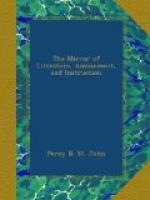Captain Stirling observes, that coal was not found, because it was not particularly sought for; but he is of opinion that the general character of the country is such as to warrant the belief that it might be found; “for,” he observes, “all the concomitant strata or members of the coal formation are exposed on different parts of the surface, below which I had no opportunity to explore. Indeed, the carboniferous order of locks is that which is most frequently exhibited throughout this territory; and I have no doubt important results would arise from a proper examination into its mineralogical resources.”
With reference to a supply of fresh water, so indispensably necessary in every settled country, the researches made by Captain Stirling and Mr. Fraser were attended with the most satisfactory results. The former observes, that the clouds which are impelled against the western side of the range of mountains are condensed into rain, the water of which is conducted across the plain to the sea, in numerous streams, but chiefly by three principal rivers, terminating in estuaries, or salt-water lakes. These are—the Swan River, opposite the Island Rottenest; the Riviere Vasse, and Port Leschenault, in Geographer’s Bay. “We found,” says Captain Stirling, “a great number of creeks, or rivulets, falling into Swan River, more particularly on the eastern side; and I am inclined to think, that the country generally is much divided by such water-courses. Its supply of fresh water, from springs and lagoons, is abundant; for we found such wherever we thought it necessary to ascertain their existence. At Point Heathcote,” he adds, “we met with a remarkable instance; for there the beach of a narrow rocky promontory is a bed of springs, and by tracing the finger along any part within four inches of the edge of the salt water, pure and fresh water instantly occupied the trace.”
Mr. Fraser’s testimony leaves no doubt of the abundance of fresh water. “I was astonished,” he says, “at the vivid green of the Eucalyptus, and other trees and shrubs, so distinct from those of New South Wales; but, on digging the soil to the depth of two feet, I found the cause to arise apparently from the immense number of springs with which this country abounds; for, at the depth above mentioned, I found the soil quite moist, although evidently at the latter end of an exceedingly dry season; and from the same cause must arise the great luxuriance of the herbaceous plants on the banks, which exceeds any thing I ever saw on the east coast. They consist principally of the senecia and the sonchus, which here attain the height of nine feet.”
He further observes, that numerous active springs issue from the rocks of the limestone ridge, and particularly in Geographer’s Bay, the whole coast of which, he says, “is a perfect source of active springs, discharging themselves on the beach in rapid rills of considerable extent, every six or seven yards.”




